| Listing 1 - 10 of 66 | << page >> |
Sort by
|
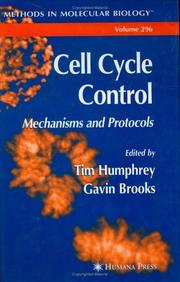
ISBN: 1280359587 9786610359585 1592598579 1588291448 Year: 2005 Publisher: Totowa, NJ : Humana Press : Imprint: Humana,
Abstract | Keywords | Export | Availability | Bookmark
 Loading...
Loading...Choose an application
- Reference Manager
- EndNote
- RefWorks (Direct export to RefWorks)
Our understanding of the cell cycle and its regulation has significantly increased with recent discoveries of links to DNA repair, growth, cellular metabolism, development, cell death, proliferative disease, cardiovascular diseases, and cancer. In Cell Cycle Control: Mechanisms and Protocols, internationally recognized researchers not only provide overviews of cell cycle regulatory mechanisms, but also set forth their best techniques for studying the eukaryotic cell cycle and its key regulatory molecules in many major research organisms. Described in step-by-step detail, these readily reproducible methods enable fundamental research on well-defined cell cycle regulators-and those more recently defined-in yeasts, bacteria, plants, Drosophila, Xenopus, and mammals. The protocols follow the successful Methods in Molecular Biology™ series format, each offering step-by-step laboratory instructions, an introduction outlining the principle behind the technique, lists of the necessary equipment and reagents, and tips on troubleshooting and avoiding known pitfalls. Comprehensive and cutting-edge, Cell Cycle Control: Mechanisms and Protocols offers all cell researchers an indispensable collection of critical reviews and techniques essential to investigate how normal cells divide and how this is altered in disease.
Cytology. --- Cell Biology. --- Cell biology --- Cellular biology --- Biology --- Cells --- Cytologists
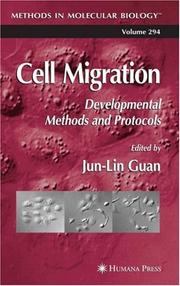
ISBN: 1280359552 9786610359554 1592598609 1588293823 Year: 2005 Publisher: Totowa, NJ : Humana Press : Imprint: Humana,
Abstract | Keywords | Export | Availability | Bookmark
 Loading...
Loading...Choose an application
- Reference Manager
- EndNote
- RefWorks (Direct export to RefWorks)
Central to the better understanding of both molecular mechanisms and disease, cell migration plays an essential role in a variety of biological processes and is now the subject of intense study using an array of powerful new technologies. In Cell Migration: Developmental Methods and Protocols, researchers describe in step-by-step detail their most successful techniques for studying the macromolecular machinery of cell movement. These readily reproducible protocols include a wide range of novel and state-of-the-art methodologies, as well as many classic methods, for use in cultured cells, different model organisms, and specialized cells in both normal development and disease. Highlights include basic assays that apply to all cell migration studies in vitro, assays in various model organisms, and assays for cancer cells, endothelial cells, and neurons both in vitro and in animal models. The authors also offer several novel approaches to the study of cell migration, as well as extensive coverage of cell migration studies in developmental and disease models. The protocols follow the successful Methods in Molecular Biology™ series format, each offering step-by-step laboratory instructions, an introduction outlining the principle behind the technique, lists of the necessary equipment and reagents, and tips on troubleshooting and avoiding known pitfalls. Comprehensive and highly practical, Cell Migration: Developmental Methods and Protocols offers researchers easy access to many readily reproducible techniques for the optimally productive investigation of cell migration in today's interdisciplinary experimental environment.
Cytology. --- Cell Biology. --- Cell biology --- Cellular biology --- Biology --- Cells --- Cytologists

ISBN: 0080457789 9780080457789 0123646510 9780123646514 0123646472 9780123646477 9786610633449 1280633441 Year: 2005 Publisher: New York : Academic Press,
Abstract | Keywords | Export | Availability | Bookmark
 Loading...
Loading...Choose an application
- Reference Manager
- EndNote
- RefWorks (Direct export to RefWorks)
International Review of Cytology presents current advances and comprehensive reviews in cell biology - both plant and animal. Authored by some of the foremost scientists in the field, each volume provides up-to-date information and directions for future research. Articles in this volume address the Keratins of the human hair follicle; calcium channels and Ca2+ fluctuations in sperm physiology; genomic imprinting: cis-acting sequences and regional control; insulin-like growth factor signaling in fishes; cell biology of cardiac cushion development.
Cytology. --- Biology. --- Life sciences --- Life (Biology) --- Natural history --- Biology --- Cells --- Cell biology --- Cellular biology

ISBN: 0123646464 9780123646460 9786610628605 128062860X 0080457762 Year: 2005 Publisher: New York : Academic Press,
Abstract | Keywords | Export | Availability | Bookmark
 Loading...
Loading...Choose an application
- Reference Manager
- EndNote
- RefWorks (Direct export to RefWorks)
International Review of Cytology presents current advances and comprehensive reviews in cell biology - both plant and animal. Authored by some of the foremost scientists in the field, each volume provides up-to-date information and directions for future research. Articles in this volume address the pathophysiological dynamics of human ovarian surface epithelial cells in epithelial ovarian carcinogenesis; morphodynamics of the secretory pathway; aspects of collagen mineralization in hard tissue frmation; the hypoxia-inducible factor and tumor progression along the angiogenic pathway; multidrug
Biology --- Cytology. --- Biology. --- Life sciences --- Biomass --- Life (Biology) --- Natural history --- Cell biology --- Cellular biology --- Cells

ISBN: 159259901X 1280358149 9786610358144 1588292762 Year: 2005 Publisher: Totowa, NJ : Humana Press : Imprint: Humana,
Abstract | Keywords | Export | Availability | Bookmark
 Loading...
Loading...Choose an application
- Reference Manager
- EndNote
- RefWorks (Direct export to RefWorks)
The combination of nanoscience and biotechnology promises to yield revolutionary biological insights, ranging from receptor function to drug discovery to personal medicine. In NanoBiotechnology Protocols, hands-on experts in nanomaterial synthesis and application describe in detail the key experimental techniques currently employed in novel materials synthesis, dynamic cellular imaging, and biological assays. The authors emphasize diverse strategies to synthesize and functionalize the use of nanoparticles for biological applications. Additional chapters focus on the use of biological components (peptides, antibodies, and DNA) to synthesize and organize nanoparticles to be used as a building block in larger assemblies. These new materials make it possible to image cellular processes for longer durations, leading to high throughput cellular-based screens for drug discovery, drug delivery, and diagnostic applications. Highlights include overview chapters on quantum dots and DNA nanotechnology, and cutting-edge techniques in the emerging nanobiotechnology arena. A value-added compact disk containing color figures is included. The protocols follow the successful Methods in Molecular Biology™ series format, each offering step-by-step laboratory instructions, an introduction outlining the principle behind the technique, lists of the necessary equipment and reagents, and tips on troubleshooting and avoiding known pitfalls. Illuminating and cross-disciplinary, NanoBiotechnology Protocols enables novice and experienced researchers alike to quickly come up to speed with both nanomaterials preparation and the use of nanomaterials in biological and medicinal applications.
nanobiotechnologie --- antilichaam --- dna --- celinteractie --- immunologie --- Contains audio-visual material --- Cytology. --- Cell Biology. --- Cell biology --- Cellular biology --- Biology --- Cells --- Cytologists
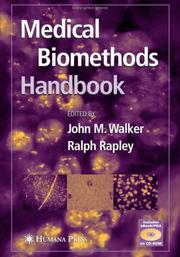
ISBN: 1280359463 9786610359462 1592598706 1588292886 Year: 2005 Publisher: Totowa, NJ : Humana Press,
Abstract | Keywords | Export | Availability | Bookmark
 Loading...
Loading...Choose an application
- Reference Manager
- EndNote
- RefWorks (Direct export to RefWorks)
Powerful new techniques in molecular biology have revolutionized our ability to investigate and define cellular processes at the molecular level for medical purposes. In Medical Biomethods Handbook, John Walker and Ralph Rapley have collected a wide-ranging group of molecular and biochemical techniques that are the most frequently used in medical and clinical research, especially diagnostics. The authors-well-established investigators who run their own research programs and use the methods on a regular basis-outline the practical procedures for using them and describe a variety of pertinent applications. Among the technologies presented are Southern and Western blotting, electrophoresis, PCR, cDNA and protein microarrays, liquid chromatography, in situ hybridization, karyotyping, flow cytometry, bioinformatics, genomics, and ribotyping. The applications include assays for mutation detection, mRNA analysis, chromosome translocations, inborn errors of metabolism, protein therapeutics, and gene therapy. State-of-the-art and highly practical, Medical Biomethods Handbook offers novice and experienced researchers an in-depth understanding of the theory, practice, and application of the key molecular biology techniques used in biomedical research and diagnostic investigation today.
Life sciences. --- Cell biology. --- Life Sciences. --- Cell Biology. --- Cell biology --- Cellular biology --- Biology --- Cells --- Biosciences --- Sciences, Life --- Science

ISBN: 1280956348 9786610956340 0387276513 1417578963 0306482355 1441934375 Year: 2005 Publisher: Boston, MA : Springer US,
Abstract | Keywords | Export | Availability | Bookmark
 Loading...
Loading...Choose an application
- Reference Manager
- EndNote
- RefWorks (Direct export to RefWorks)
Selective Sweep deals with the theory and practice of detection of recent adaptive evolution at the genomic level from the patterns of DNA polymorphism. Recent advances in genomic sequencing provide the background for analysis of polymorphic sites in large chromosomal regions or even in whole genome, thus providing the tool for effective identification of loci that are under strong pressure of positive selection. For this reason, the studies of selective sweep, which formerly were of interest mostly to evolutionists, have become widely recognized and appreciated by the large biological community involved in identification of the targets of selection during speciation, host/pathogen interactions, and resistance to chemical agents.
Mutation (Biology) --- Population genetics. --- Natural selection. --- Darwinism --- Selection, Natural --- Genetics --- Variation (Biology) --- Biological invasions --- Evolution (Biology) --- Heredity --- Cytology. --- Cell Biology. --- Cell biology --- Cellular biology --- Biology --- Cells --- Cytologists
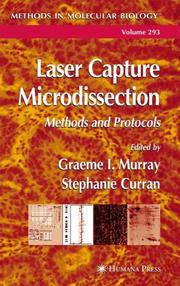
ISBN: 1280359625 9786610359622 1592598536 1588292606 Year: 2005 Publisher: Totowa, NJ : Humana Press : Imprint: Humana,
Abstract | Keywords | Export | Availability | Bookmark
 Loading...
Loading...Choose an application
- Reference Manager
- EndNote
- RefWorks (Direct export to RefWorks)
Use of laser microdissection has grown enormously to become a very powerful high-throughput technology essential to a range of downstream applications in pathology, cancer research, life sciences, medical diagnostics, and biotechnology. In Laser Capture Microdissection, expert laboratory researchers noted for their optimized methods describe in step-by-step detail not only how to successfully carry out tissue-based laser microdissection in their own laboratories using the different systems available, but also how to apply a wide range of sophisticated molecular technologies to the microdissected tissue samples. These readily reproducible methods make it possible to carry out contamination-free molecular analyses of specific types of normal and diseased cells. Highlights include gene expression profiling of primary tumor cell populations, RNA transcript amplification and GeneChip® microarrays, colorectal cancer proteomics, and proteomic analysis of human bladder tissue using the SELDI® approach. Applications of the microdissected tissue described encompass PCR, gene expression studies including microarray analysis, and proteomics. The protocols follow the successful Methods in Molecular Biology™ series format, each offering step-by-step laboratory instructions, an introduction outlining the principle behind the technique, lists of the necessary equipment and reagents, and tips on troubleshooting and avoiding known pitfalls. Comprehensive and state-of-the-art, Laser Capture Microdissection provides a highly practical guide to successful tissue-based laser microdissection using available commercial systems and to the interpretation of the results using a wide range of sophisticated molecular technologies.
Biochemistry. --- Cytology. --- Biochemistry, general. --- Cell Biology. --- Cell biology --- Cellular biology --- Biology --- Cells --- Cytologists --- Biological chemistry --- Chemical composition of organisms --- Organisms --- Physiological chemistry --- Chemistry --- Medical sciences --- Composition
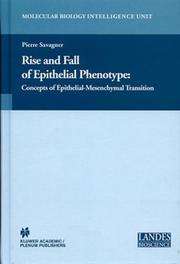
ISBN: 1280945036 9786610945030 0387286713 1423724089 0306482398 1441934391 Year: 2005 Publisher: New York, NY : Springer US : Imprint: Springer,
Abstract | Keywords | Export | Availability | Bookmark
 Loading...
Loading...Choose an application
- Reference Manager
- EndNote
- RefWorks (Direct export to RefWorks)
Epithelial phenotype is a dynamic stage of differentiation that can be modulated during several physiological or pathological events. The rapid conversion to a mesenchymal-like phenotype is called an epithelial-mesenchymal transition (EMT). The Rise and Fall of Epithelial Phenotype is the first book to comprehensively introduce the concept of EMT. The first part of this volume describes main examples and models and explains their physiological relevance. These examples include hydra morphogenesis, gastrulation in mouse, drosophila and sea urchin, as well as neural crest cell migration and heart morphogenesis in vertebrates. Part two reviews in detail, specific EMT molecular pathways covering extracellular induction, transduction and transcription response and modulation of cell-cell adhesion structures. It emphasizes new specific pathways with potential medical applications. EMTs can also be linked to pathological events such as wound healing and cancer progression, as detailed in this section of the book.
Vertebrates --- Epithelium. --- Mesenchyme. --- Embryology. --- Connective tissues --- Tissues --- Cilia and ciliary motion --- Cytology. --- Developmental biology. --- Oncology. --- Cell Biology. --- Developmental Biology. --- Cancer Research. --- Cell biology --- Cellular biology --- Biology --- Cells --- Cytologists --- Tumors --- Development (Biology) --- Growth --- Ontogeny --- Cell biology. --- Cancer research. --- Cancer research

ISBN: 1417582758 1280800089 9786610800087 0387277471 030648241X 1441934405 Year: 2005 Publisher: New York, NY : Springer US : Imprint: Springer,
Abstract | Keywords | Export | Availability | Bookmark
 Loading...
Loading...Choose an application
- Reference Manager
- EndNote
- RefWorks (Direct export to RefWorks)
Nuclear Import and Export in Plants and Animals provides insight into the remarkable mechanisms of nuclear import and export. This book covers a range of topics from the nuclear pore structure, to nuclear import and export of macromolecules in plant and animal cells. In addition, the book covers the special cases of nuclear import of Agrobacterium T-DNA during plant genetic transformation, nuclear import and export of animal viruses, and nuclear intake of foreign DNA. A chapter on research methods to study nuclear transport concludes the book.
Nuclear membranes. --- Biological transport. --- Proteins --- Physiological transport. --- Membrane transport --- Passive transport, Biological --- Physiological transport --- Transport, Biological --- Diffusion --- Osmosis --- Nuclear envelope --- Cell membranes --- Cell nuclei --- Cytology. --- Cell Biology. --- Cell biology --- Cellular biology --- Biology --- Cells --- Cytologists --- Cell biology.
| Listing 1 - 10 of 66 | << page >> |
Sort by
|

 Search
Search Feedback
Feedback About
About Help
Help News
News